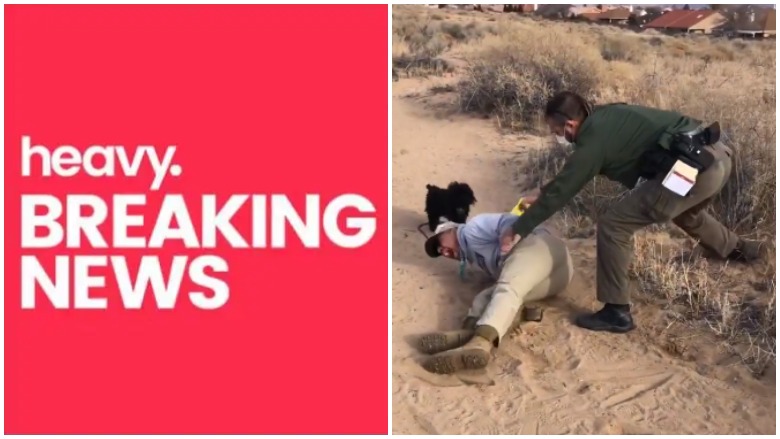
Instagram/@hou5edm Native American man Darrell House was tased after going off the designated trail at a national park in New Mexico & refusing to show ID.
Darrell House is the Native American man who says he was unfairly targeted by a national park ranger while he was walking his dog in New Mexico. House, who identified himself as a Marine Corps veteran, shared a video on Instagram that shows the ranger hit him with a taser multiple times.
The confrontation happened on December 27 at the Petroglyph National Monument in Albuquerque. House said he had walked off the designated trail but returned to it when the park ranger asked him to do so. But when the ranger asked for House’s identification, House refused to comply, as evidenced on the Instagram video.
The National Park Service, in a statement to KRQE-TV, said the department’s internal affairs unit was reviewing the incident and that the agency takes “any allegation of wrongdoing very seriously, and appreciate the public’s patience as we gather the facts of this incident.” The agency has since released more than nine minutes of footage from the ranger’s body camera and details are below.
Here’s what you need to know:
1. The National Park Service Says Darrell House & His Sister Initially Provided Fake Names & the Agency Has Released Footage From the Ranger’s Body Camera
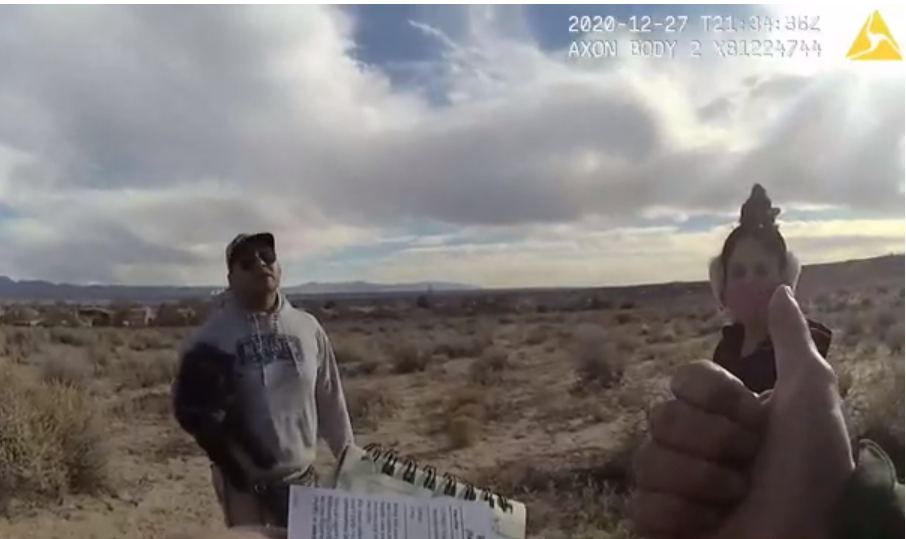
National Park ServiceThe National Park Service released the ranger’s body camera footage from the interaction with Darrell House.
The National Park Service has released new details about the confrontation between House and the park ranger since House’s Instagram footage went viral online. According to the federal agency, the park ranger saw House and his sister “climbing on and among petroglyph cliff features off trail.” The agency noted that the cliffs are “a protected, sacred archeological site” and visitors are prohibited from walking on them.
According to a press release from the National Park Service, the ranger said he instructed House and his sister to return to the trail and attempted to resolve the interaction with an educational contact and simple warning. The agency claims that when the ranger initially asked for their identification, House and his sister both “provided fake names and dates of birth to the officer.”
The Park Service has also made footage from the ranger’s body camera available and you can watch it here. The more than 9-minute clip shows the interaction between House and the ranger before the confrontation escalated.
The body camera footage shows the ranger explaining to House and his sister that the petroglyphs are “super sacred to the tribes. They don’t want anyone up there.” House’s verbal response was difficult to make out but he held up a necklace and it’s likely he was telling the ranger that he is Native American. The ranger adds that it’s important to keep pets off the trail and within fenced-in areas.
The ranger then asks House and his sister whether they have identification. House does not answer, turns away and his sister starts to follow. The ranger calls out, “Sir, you’re not free to go right now, hold on.” The ranger goes on, “Hey bud, listen. You’re not free. Do not do it like this, ok. Please don’t be like that.” House picks up his dog and turns to face the ranger who explains, “This is just a simple contact that is honestly a warning. I don’t expect it being more than that.” House answers that the ranger doesn’t need his identification and when asked, his sister confirms that she doesn’t have an ID with her.
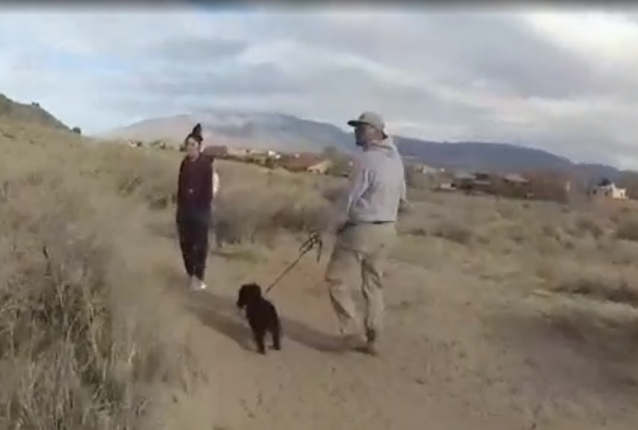
National Park ServiceThe National Park Service released the ranger’s body camera footage from the interaction with Darrell House.
House proceeds to tell the ranger that he is a military veteran and was simply trying to enjoy the hike while “on holiday from North Carolina.” He explains that he hadn’t wanted to be near a larger group of people on the trail due to social distancing concerns.
In the clip, the ranger continues to explain that he was trying to do his job in protecting the sacred site because some visitors tend to vandalize it. The ranger says he just needs a written record that he had given House a warning about staying on the designated trail. When House again refuses to provide identification, the ranger asks the sister for his name. She says his name is “Jerald.” House proceeds to spell the false name for the ranger, who writes it down. House then refuses to give a last name. The ranger asks if there is a warrant out for him because otherwise, he doesn’t understand why disclosing his name is a concern. House responds there’s no warrant but still doesn’t want to provide it. House continues, “Natives Americans and the government and law don’t mesh well, you know that. We’ve had our differences before. You’re on our land.”
The ranger says he sympathizes with House’s feelings on that but insists “this is simply a law enforcement action today. You just need to provide your name and we’re done.” At approximately the 4:26 point in the video, House claims his last name is Humphrey. The ranger says he needs to clear with dispatch and thanks them for their cooperation as House walks away with his dog. In the video, the ranger is heard asking a colleague over the radio to look up the name “Jerald Humphrey.” The ranger and the sister walk to where House was standing with his dog. The ranger then explains that House cannot leave until the ranger can confirm his identification and will be detained if he refuses to comply. This where the video begins to correlate with the footage House later shared on Instagram.
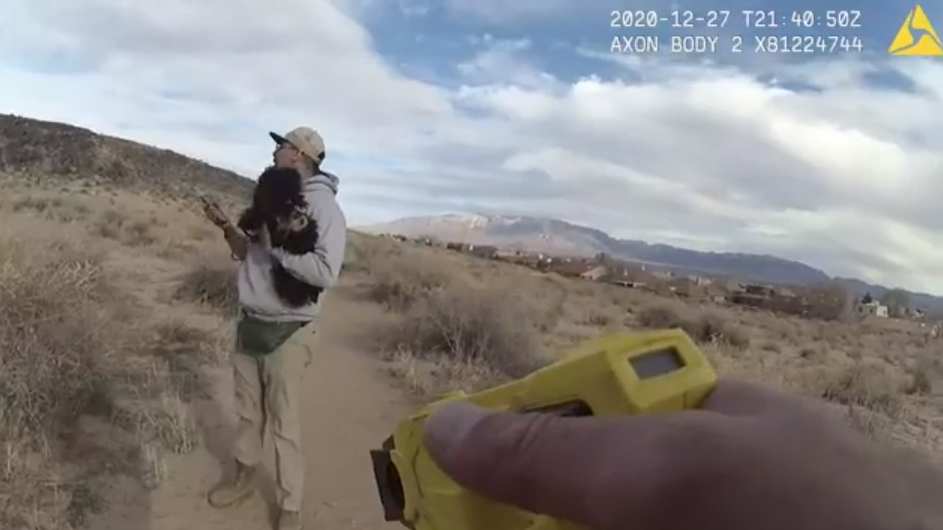
National Park ServiceThe National Park Service released the ranger’s body camera footage from the interaction with Darrell House.
The ranger asks House to give the woman the dog. House replies, “My dog ain’t going anywhere.” At the 7:30 mark, as House tries to walk away again, the ranger warns him, “Stop walking or you may be tased.” The ranger orders House to put the dog down three times but House does not comply. House then begins shouting for help moments before the ranger deploys the taser.
The National Park Service says the confrontation is under internal review by the NPS Office of Professional Responsibility. Investigators say the probe will include interviews with both park rangers involved, House and his sister and any other witnesses. The press release added that “investigators will also review the video captured by one of the individuals and later posted to social media, as well as the body worn camera footage worn by the NPS law enforcement officer.”
House was not arrested but issued three citations for providing false information, failing to comply with a lawful order and being in a closed area of the park. His sister was also cited for being in a closed area off-trail and for providing false information.
2. Darrell House Said He Walked Off the Trail to Ensure Social Distancing as a Larger Group Approached Him
House visited the national park on December 27 with his sister and his small dog, Geronimo. He explained to KRQE-TV that as they walked on the Piedra Mercado trail, he noticed a larger group of people approaching from the other direction. House told the outlet he decided to walk off the trail in order to maintain social distancing amid the ongoing coronavirus pandemic and allow the larger group more room on the trail.
A park ranger was nearby and instructed House to return to the established trail. House said he complied with the ranger’s request but then refused to hand over any identification after the ranger asked for it. As the ranger’s body camera footage showed, the exchange went on for several minutes as the ranger explained he needed the ID to show he had issued a warning to remain off the rocks.
House recorded part of the exchange about identitrication and shared it on Instagram. In the clip, the ranger explains that he will be detained for refusing to show identification. House tells the ranger, “You’re not gonna touch me sir” before the short video ends. House explained his reasoning in the caption for the longer video: “I didn’t feel I needed to identify myself for doing absolutely nothing wrong.”
3. House Yelled for Help & Refused to Comply as the Park Ranger Repeatedly Ordered House to Put His Hands Behind His Back
The nearly five-minute video recorded by House’s sister has been viewed thousands of times on his Instagram account. The video begins with the park ranger moving toward House while pointing the taser in his direction. House is heard screaming for help as his sister asks over and over again, “Why are you doing this?”
The ranger deploys the taser after asking House’s sister to tell him to put the dog down. House told KRQE-TV the shock of the taser caused him to fall to the ground and drop his dog. House added that his dog felt the shock from the taser as well.
In the clip, House screams in pain and rolls on the ground after he’s hit with the taser. The ranger approaches him and demands to see House’s hands as the man keeps yelling. The ranger appears to deploy the taser again while House is on his knees, which prompts House to put his hands in front of his body as if to shield himself. The ranger makes a move to put House in handcuffs but House rolls away and insists he doesn’t have anything in his hands.
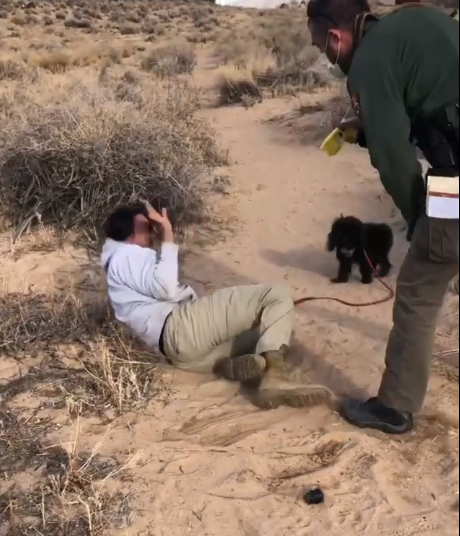
Instagram/@hou5edmNative American man Darrell House was tased after going off the designated trail at a national park in New Mexico.
The next couple of minutes consists of the ranger repeatedly demanding that House put his hands behind his back and sit down. House continues to insist that he didn’t do anything wrong and didn’t have anything in his hands. The ranger verbally threatens to use the taser again if House does not comply. At one point, House lifts both arms up in the air and shouts for someone else in the park to help him. “This guy is hurting me! He’s tasing me!”
A second ranger eventually arrives and was also holding a taser. House eventually sits down as requested; his sister is heard off-camera telling him to listen to the instructions. He asks why he is being arrested. The ranger explains he is being detained, not arrested, for refusing to identify himself and that the second ranger was going to put him in handcuffs. The ranger says, “If you resist, I will tase you. Do you understand that?” House doesn’t resist and the video ends as the ranger walks toward House’s sister to ask her whether she had her identification on her. Her response wasn’t recorded.
4. House Said He Routinely Visits the Park to Pray & Often Goes Off the Trail
House wrote in the caption of his Instagram video that his ancestry includes Navajo and Oneida lineage but that he often visits the national monument in order to “pray and speak to my Pueblo Ancestor relatives.” House further explained to KOB-TV that he typically moves away from the designated trails to meditate and pray near the rocks.
House expressed confusion over the confrontation with the park ranger. “I didn’t harm anyone. I didn’t cause any harm to anybody. I wasn’t disorderly. I wasn’t on any substances,” House told the outlet. “This has been going for years. I’m practicing my religious rights on my ancestral land.”
House also told NBC News he grew up on a reservation and has never had any issues with law enforcement near the hiking trails before. (But as seen in the body camera footage released from the National Park Service, House initially claimed to be on vacation from North Carolina).
The Petroglyph National Monument features more than 25,000 designs and symbols carved into 17 miles of volcanic rock. Archaeologists estimate 90% of the carvings were completed by Pueblo people between 400 and 700 years ago, the NPS explains on its website. The Pueblo people have lived in the area for at least 1,500 years.
The Wilderness Society, a non-profit land conservation organization, has publicly condemned the actions taken against House, pointing out that the Petroglyph National Monument was established “to protect the cultural importance of these homelands for Native people.” The organization emailed a statement to Heavy from the group’s New Mexico State Director, Michael Casaus:
Watch the video. Our eyes do not deceive us about what we see taking place on public lands. The National Park Service must commit to a fair, open, and independent investigation of these actions. Park rules are there for protecting the lands but the enforcement of those policies should not come at the expense of protecting the humanity of all those who visit, especially if these are their traditional homelands.
Our parks and open spaces should be welcoming and inclusive places of healing and comfort, yet they are not for so many, especially for Black and Indigenous people and people of color. The original purpose of the monument was to protect and promote the understanding of the petroglyphs in relation to the cultural and natural features of the West Mesa and to further the heritage of traditional communities connected to these lands. Petroglyph National Monument is a place where Native people should be able to visit and honor the past, the present and the future on the very lands their ancestors stood without fear for their safety.
5. Visitors to the Petroglyph National Monument Are Required to Stay on the Designated Trails But House Said He Feels the Rule Shouldn’t Apply to Native Americans
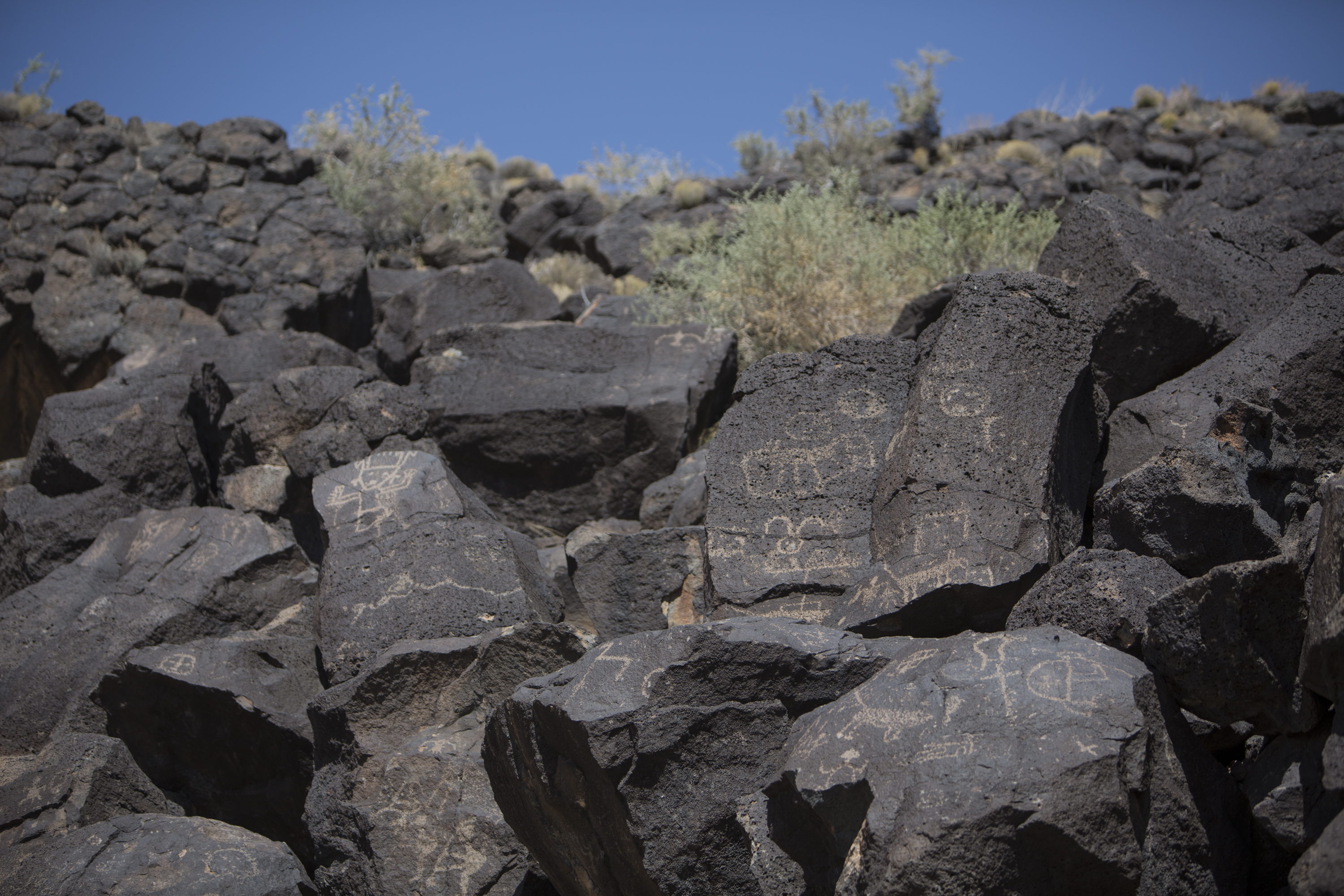
Getty Petroglyphs adorn the rocks at Petroglyph National Monument on April 19, 2018 in Albuquerque, New Mexico.
Visitors to the national park are instructed to stay on the established trails for safety reasons. The National Park Service explains on its website, “Climbing and scrambling along the volcanic boulders is unsafe since you can loosen rocks and cause a dangerous rock fall.” The agency says staying on the trails helps to preserve the rock carvings and the landscape.
House argues this rule should not extend to Native Americans. He wrote on Instagram, “If anyone has the right to be off trail and wander this land, it’s the NATIVE INDIGENOUS COMMUNITY!” He also told KRQE-TV, “I will go back. I am going to continue to do my prayers, going off trail without permission. Without consent. That is my right.”
But the park ranger also appears to have had the authority to ask for House’s identification. National park rangers are employees of the Department of the Interior.
According to a National Park Service Law Enforcement Program reference manual, Interior Department employees acting in a law enforcement capacity are legally permitted to carry firearms and make arrests. Amendments made to the General Authorities Act in 1976 ensured that National Park Service officers were granted the same law enforcement authority “consistent with the authority exercised by other Federal personnel having law enforcement responsibilities, such as agents of the Federal Bureau of Investigation (FBI) and United States Marshals, and specifically would not restrict their investigative jurisdictions.”

Instagram/@hou5edmNative American man Darrell House was tased after going off the designated trail at a national park in New Mexico.
House was issued three citations for refusing to reveal his identity, being off the main trail and for “interfering with agency functions,” KOB-TV reported. But House said he felt the park ranger’s actions were overblown and argued on his Instagram account that he felt the ranger, who was white, was abusing his power. House wrote in part, “This could have been a civil interaction. The law doesn’t work for the Indigenous. The government doesn’t give a s***about us. This was uncalled for.”
House further suggested to KRQE-TV that discrimination may have been a factor. He told the outlet that he felt the ranger “wanted to show power, dominance, keep me in order. That’s what authority figures are trained to do, to keep people like me in order. To make the ‘Indian’ look crazy, to make them look insane.”
The National Park Service issued a statement to the TV station that reads in part:
On December 27, a law enforcement park ranger contacted two visitors who were walking in a closed area off-trail, which is a violation of National Park Service regulations within Petroglyph National Monument. A video capturing part of their interaction and posted to social media has generated question and interest from the public.
In accordance with National Park Service policy, this incident is under review and has been referred to the NPS Office of Professional Responsibility, our internal affairs unit, for a thorough investigation. While we work to gather the facts of this specific situation, we cannot speculate on the events leading up to what was captured on video. We take any allegation of wrongdoing very seriously, and appreciate the public’s patience as we gather the facts of this incident.
READ NEXT: WATCH: Missouri Woman Hit Sheriff’s Deputy With a Baton in Mask Dispute